Octopus stew - Spanish-style, flavoured with garlic, paprika and white wine makes a fantastic tapas-style dish. Serve with lots of crusty bread to mop up all the delicious gravy.
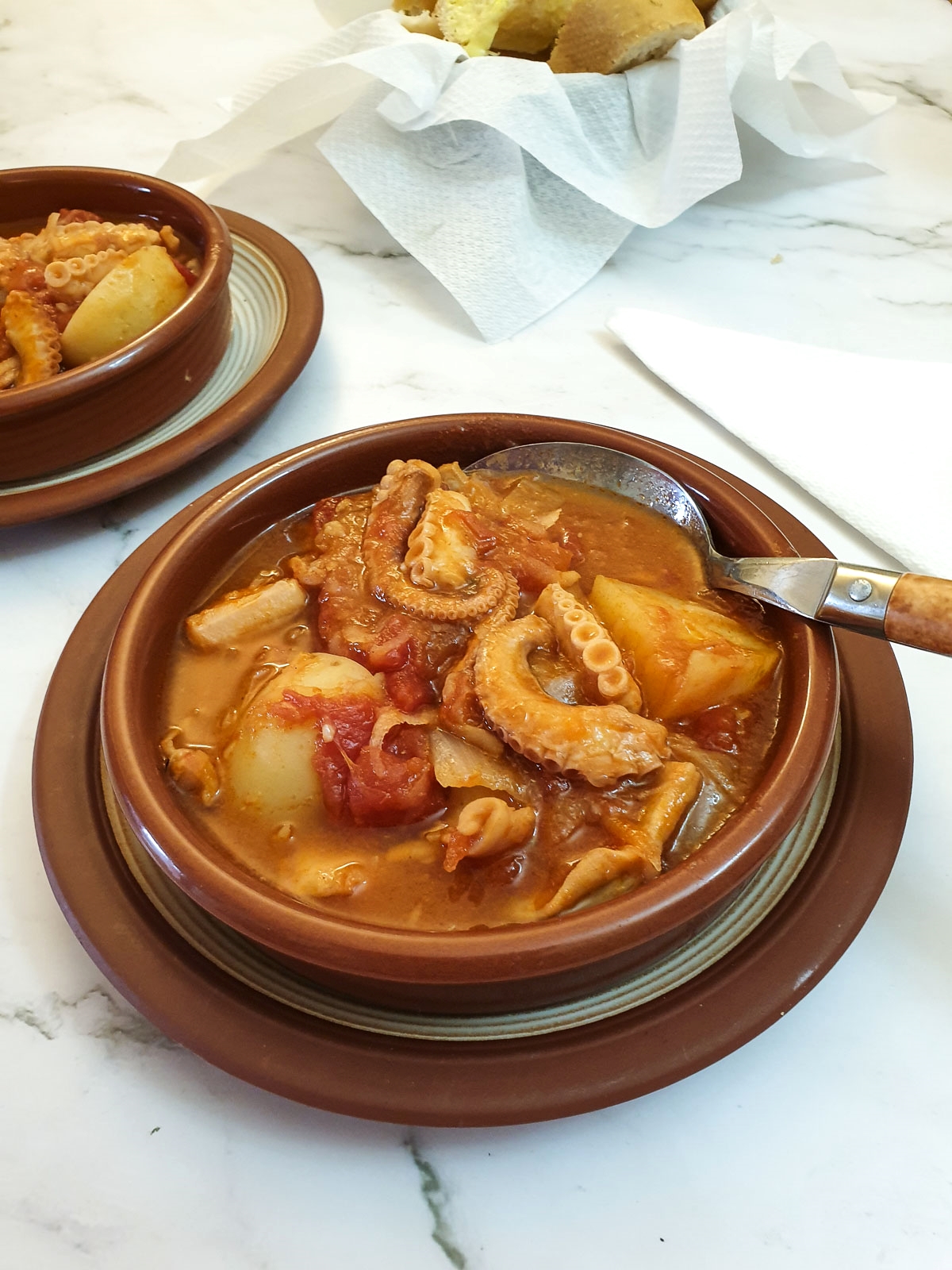
**As an Amazon affiliate, I earn from qualifying purchases.**
Jump to:
Octopus stew - Spanish style
I first tasted this octopus stew a few years ago while on holiday in Spain. I must admit, I wasn't too keen, never having eaten octopus before. But one mouthful was enough to convince me that this was something special.
The stew was made with melt-in-the-mouth tender pieces of octopus in a tasty tomato-based broth, flavoured with garlic and paprika, and packed with perfectly cooked potatoes and sweet onions.
It was part of a tapas spread that we'd ordered, and it arrived with a bowl of fresh crusty bread to soak up all the delicious gravy.
Poor hubby didn't get a look in! I left him to eat the other tapas dishes and scoffed the entire bowl of octopus stew myself (although I did let him taste one spoonful).
The only way to make it (in my opinion)
When we got back home I set about trying to recreate the octopus stew myself. The first attempt was a massive failure. I cooked it in a saucepan on the stove but didn't leave it to cook for long enough and the octopus was tough and chewy.
The second attempt wasn't much better. This was made in a casserole in the oven, and while the octopus was tender, the potatoes cooked away to mush!
The third attempt was much better. I cooked the octopus in the pressure cooker for 15 minutes, then added the potatoes and cooked it for a further 5 minutes. The outcome was almost perfect but the broth was too thin.
So - and here's the trick - I grated one of the potatoes before adding it to the pressure cooker and the result was perfect; the grated potato released enough starch to thicken the broth without the need for any thickening agents.
In my opinion, the pressure cooker route is the way to go. But don't worry, if you don't have a pressure cooker I've learned from my mistakes and included instructions for making this octopus stew either in a saucepan or in the oven, so you can get perfect results whichever way you choose to go.
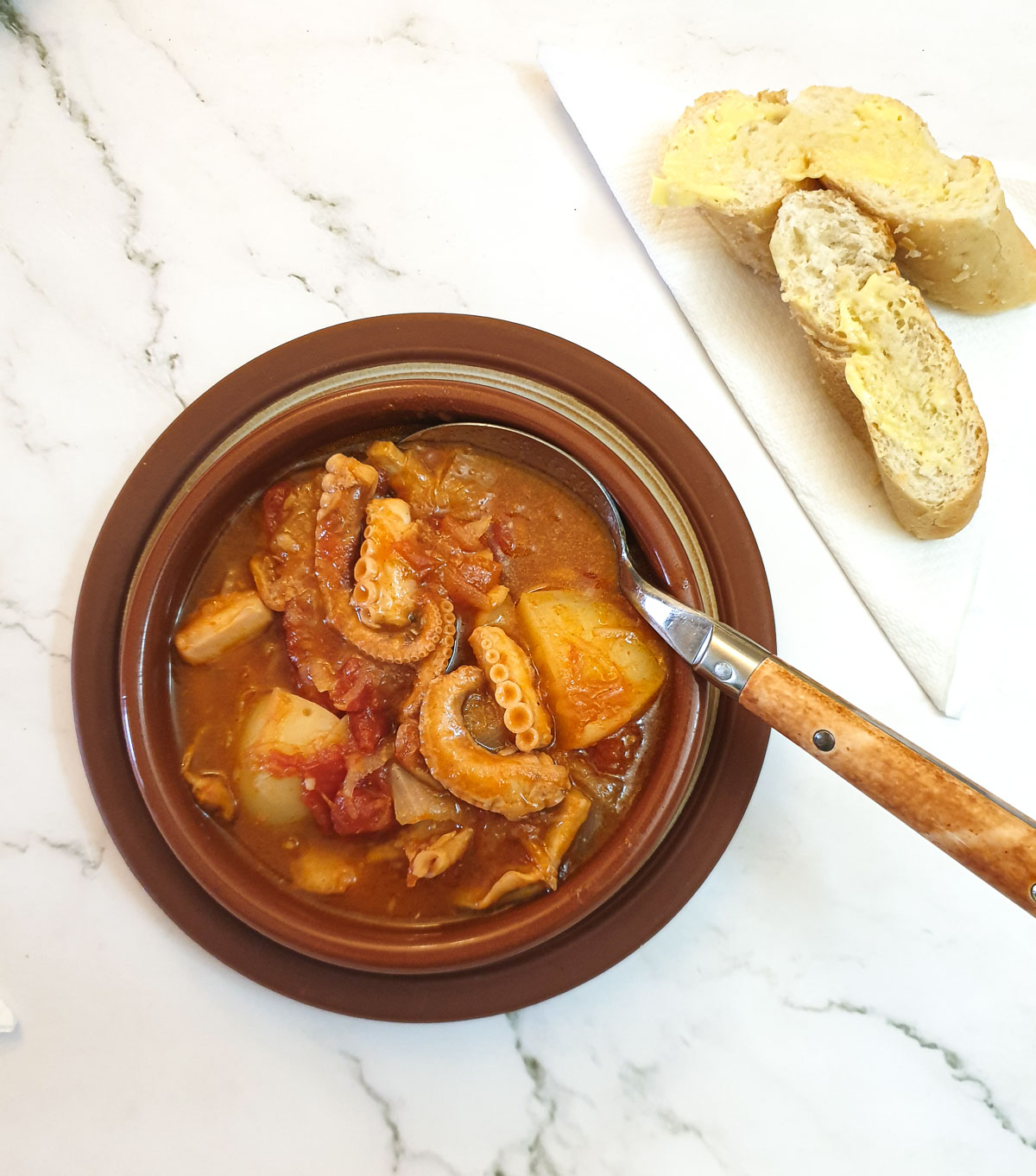
What you will need
Equipment
First and foremost you will need a pressure cooker. This is similar to the one I use, but if you don't have an electric pressure cooker, you can use a normal stove-top pressure cooker instead.
If you don't have a pressure cooker, you can use either a saucepan and cook the octopus stew on the stove, or use a casserole dish and cook it in the oven.
In addition, you will need a box grater for grating the potato, and a sharp knife and a chopping board for cutting everything up.
Ingredients
This octopus stew will serve at least 4 to 6 people as part of a tapas spread.
**You can get the complete list of ingredients and full instructions for making this octopus stew on the printable recipe card at the end of this post**
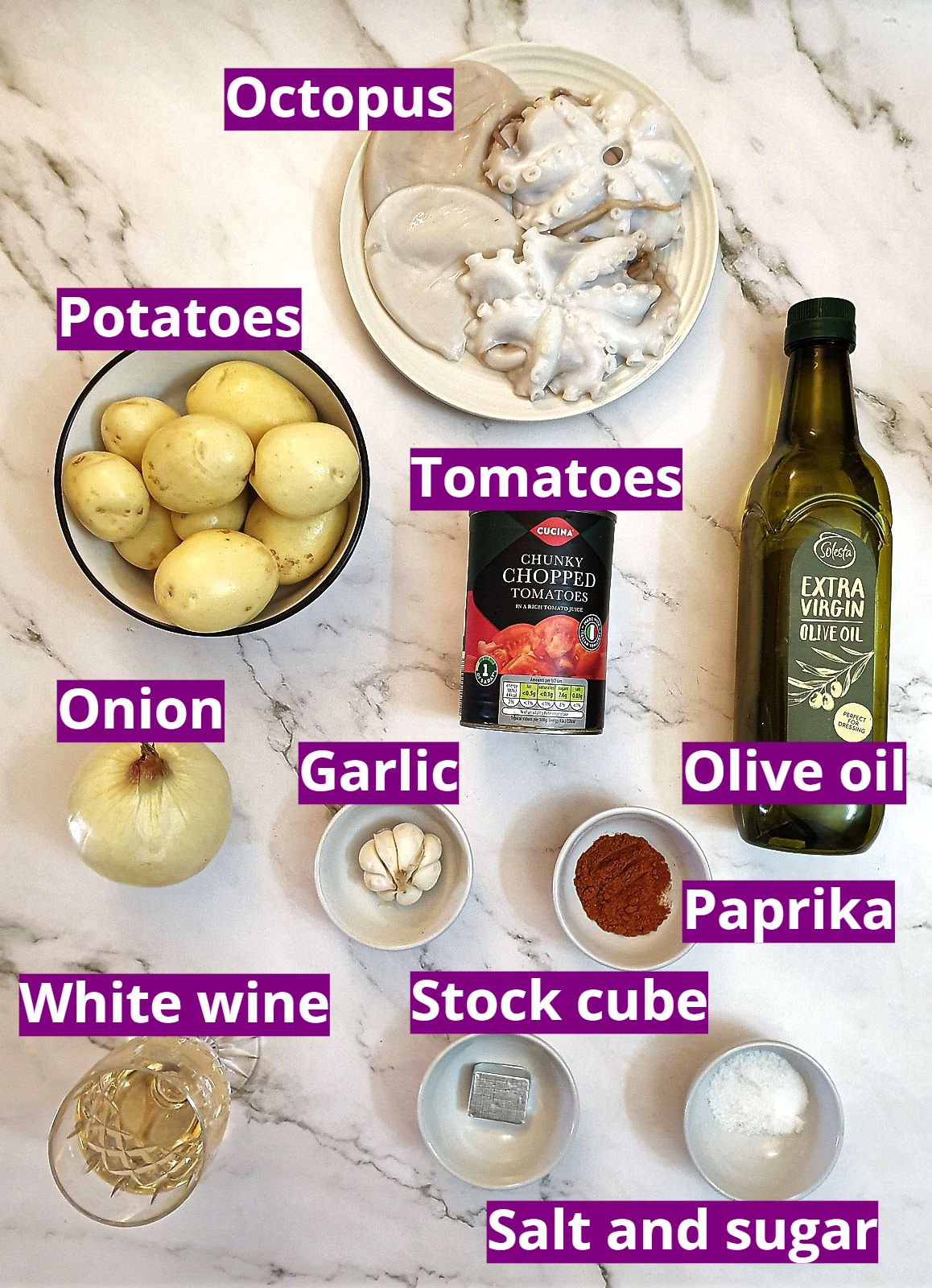
Octopus - I bought fresh octopus from my local supermarket, which had already been cleaned and prepared. You can use frozen octopus if you can't get fresh. Octopus shrinks (a lot) when it is cooked, and what looks like a large helping of raw octopus will shrink by more than half when it is cooked.
Potatoes - use waxy potatoes that don't break apart during cooking. The traditional way of preparing the potatoes for octopus stew is to cut halfway through the potatoes with a sharp knife and then break them in half so that they release their starch into the stew. I've found that the potatoes thicken the stew more easily if you grate one of the potatoes on a box grater instead.
Canned tomatoes - get a good quality canned tomato - the cheaper supermarket 'own brand' doesn't have the same depth of flavour.
Olive oil - I like to use extra virgin olive oil.
Onion - this should be cut into large pieces and separated into individual petals.
Garlic - as much as you like. You can use ready-crushed garlic from a jar if you don't have fresh garlic cloves.
Paprika - add a smokey flavour to the dish.
White wine - use wine that you would actually drink - a bad-tasting wine won't improve with flavour when cooking. If you don't want to use alcohol, substitute the wine with extra stock.
Stock cube - I like to use vegetable stock because I don't want to include any meat flavour in the dish. If you have ready-made vegetable stock, by all means, use that, but a vegetable stock cube is a perfectly acceptable alternative.
Salt and sugar - for seasoning. I always add a teaspoon of sugar whenever I'm cooking with tomatoes because I think it enhances the flavour.
These are not pictured, but sliced red peppers (capsicum) would make a tasty addition.
What to do
If you've bought octopus that has already been cleaned and cut into pieces you can skip the next 2 steps.
Start by rinsing the octopus under cold running water. Pay particular attention to the tentacles and make sure they are completely clean.
Cut the octopus
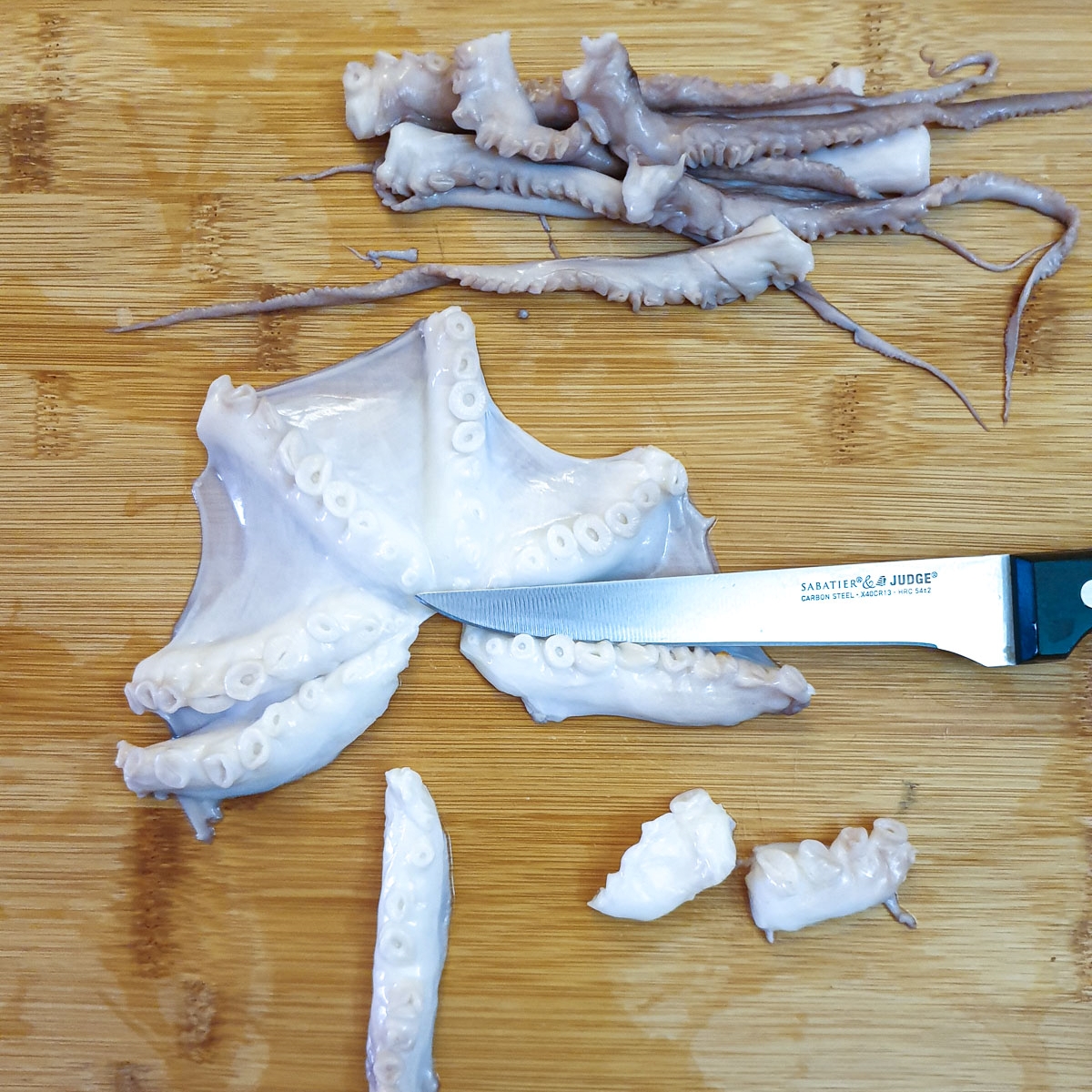
Lay the octopus out on a chopping board and cut off the tentacles.
Then cut through the membrane between the top part of the tentacles to separate them.
If the octopus is quite large you can cut these in half otherwise leave them whole.
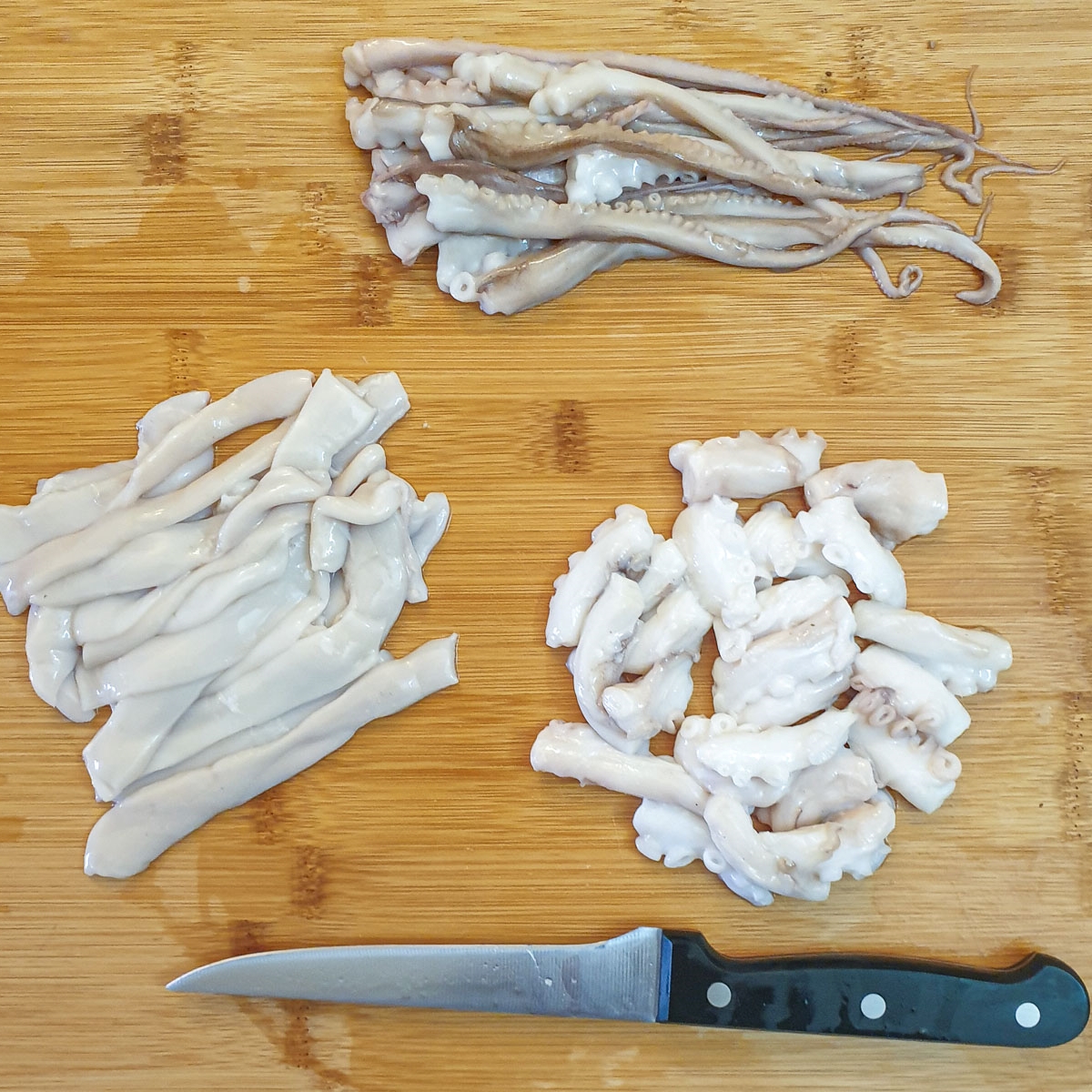
Cut the body into rings approximately one inch wide.
Once again if the octopus is quite large you can cut the rings into two halves, otherwise leave them as rings.
Make the octopus stew
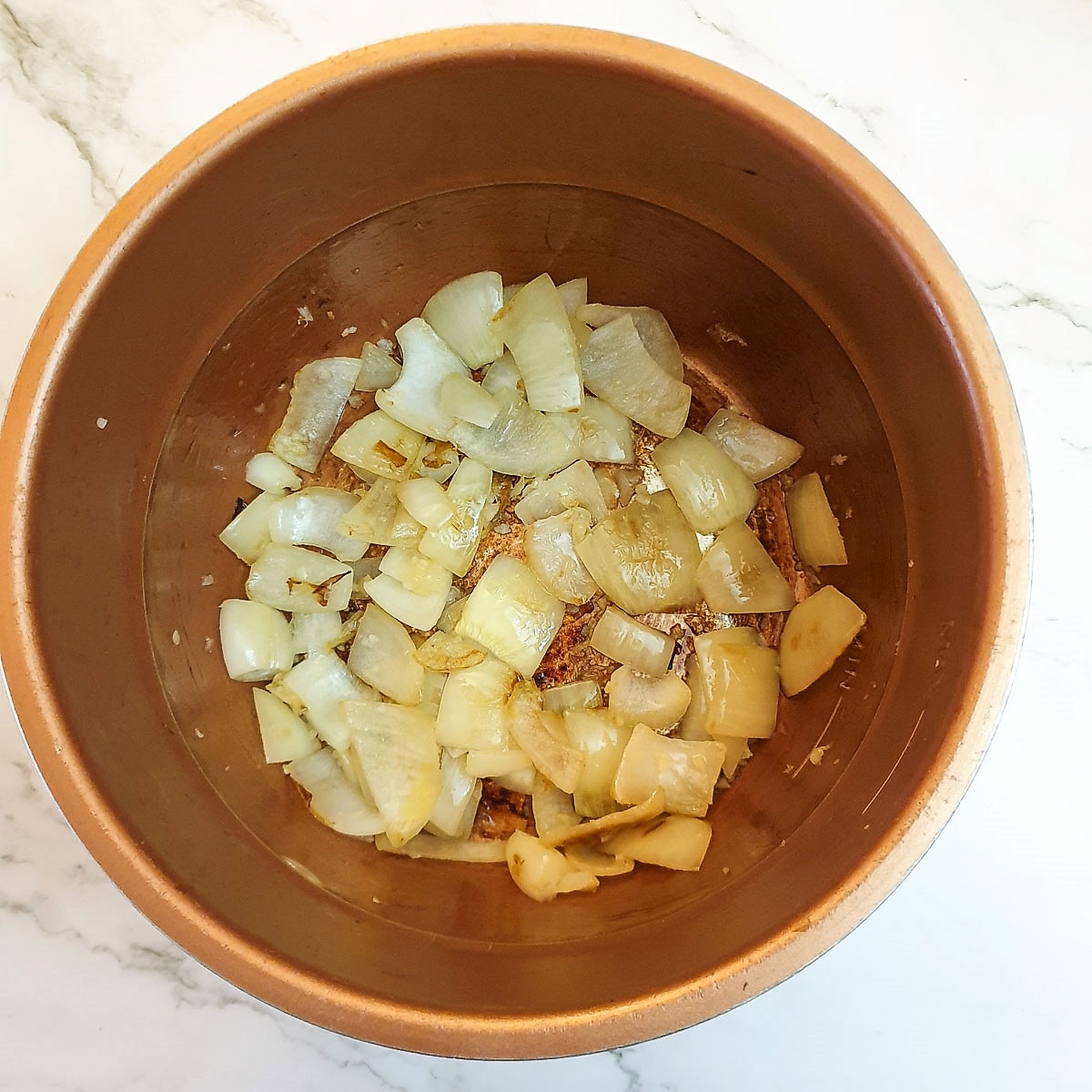
Cut the onion into largish pieces and separate the petals. Peel and mince the garlic.
Use the saute or browning function on your pressure cooker to soften the onions and garlic in 2 tablespoons of olive oil. Stir frequently so the onions don't burn. They should just turn translucent.
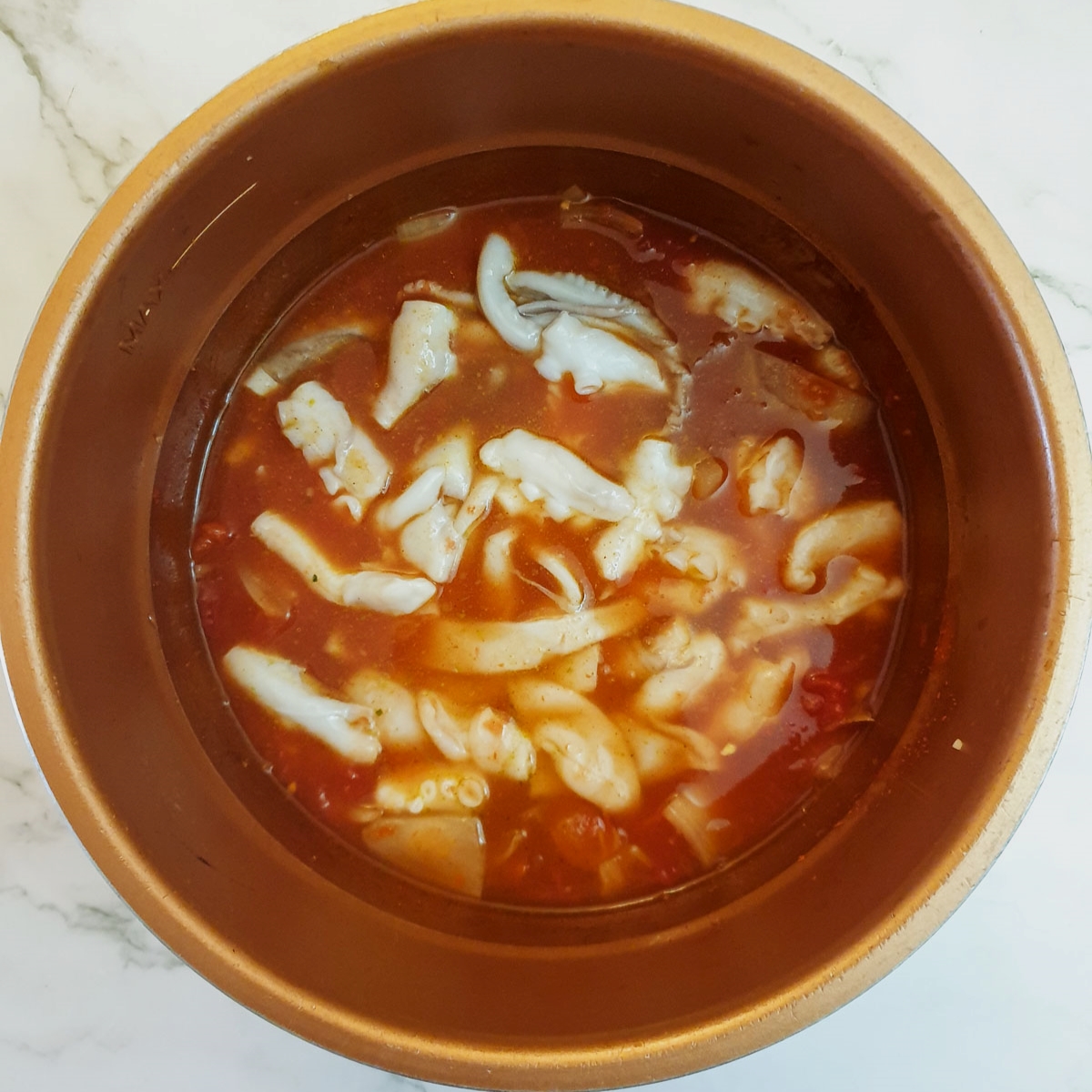
Add the stock, white wine, tomatoes, paprika, salt, sugar, and the octopus pieces.
Set the pressure cooker to the 'Stew' function and cook for 15 minutes.
Allow the pressure to release.
The octopus should be fork-tender. If your octopus is quite large it may need a few minutes longer, but remember it will be cooked for a further 5 minutes along with the potatoes.
Peel the potatoes and cut them into chunks. Keep one medium potato aside.
Grate the medium potato on the largest holes of a box grater (approximately half a cup of grated potato).
Add the grated potato to the octopus along with the remaining potatoes.
Select the 'Stew' function and cook for a further 5 minutes.

Release the pressure and check the consistency of the sauce.
It should have thickened sufficiently from the starch in the potatoes.
If the sauce seems too thin, set the pressure cooker to the saute or browning function and leave it to simmer for a few minutes (without the lid) to allow some of the liquid to evaporate.
This sauce is not meant to be too thick, it should be runny enough to soak into the crusty bread.
Serve with slices of crusty bread as part of a tapas meal.
If you'd like to be notified of any new recipes, why not subscribe to my newsletter? As a thank-you gift, you will receive a free recipe e-book containing some of my most popular cakes and desserts.
Cook on the stove
To cook octopus stew in a saucepan on the stove:
- Brown the onions lightly in olive oil in a large saucepan.
- Add the rest of the ingredients (except the potatoes).
- Cover the saucepan with a lid and simmer for 60 minutes until the calamari is fork-tender.
- Add the grated potato and the chopped potatoes and cook for another 15 to 20 minutes until the potatoes are cooked and the gravy has thickened.
- Leave the lid off the pan for the last 5 minutes to allow some of the liquid to evaporate if the sauce seems too thin.
- Check the level of the liquid occasionally and add extra stock if necessary.
Cook in the oven
To cook octopus stew in the oven:
- Brown the onions lightly in olive oil in a frying pan on the stove.
- Transfer the onions to an oven-proof casserole dish, and add the remaining ingredients (except the potatoes).
- Cover with a lid and bake in a preheated oven (200C / 400F) for 90 minutes.
- Remove from the oven and add the grated potatoes and the chopped potatoes.
- Return the dish to the oven and cook for another 40 minutes until the potatoes are done.
- Remove the lid for the last 10 minutes if the sauce seems too thin.
- Check the level of the liquid occasionally and add extra stock if it seems to be drying out.
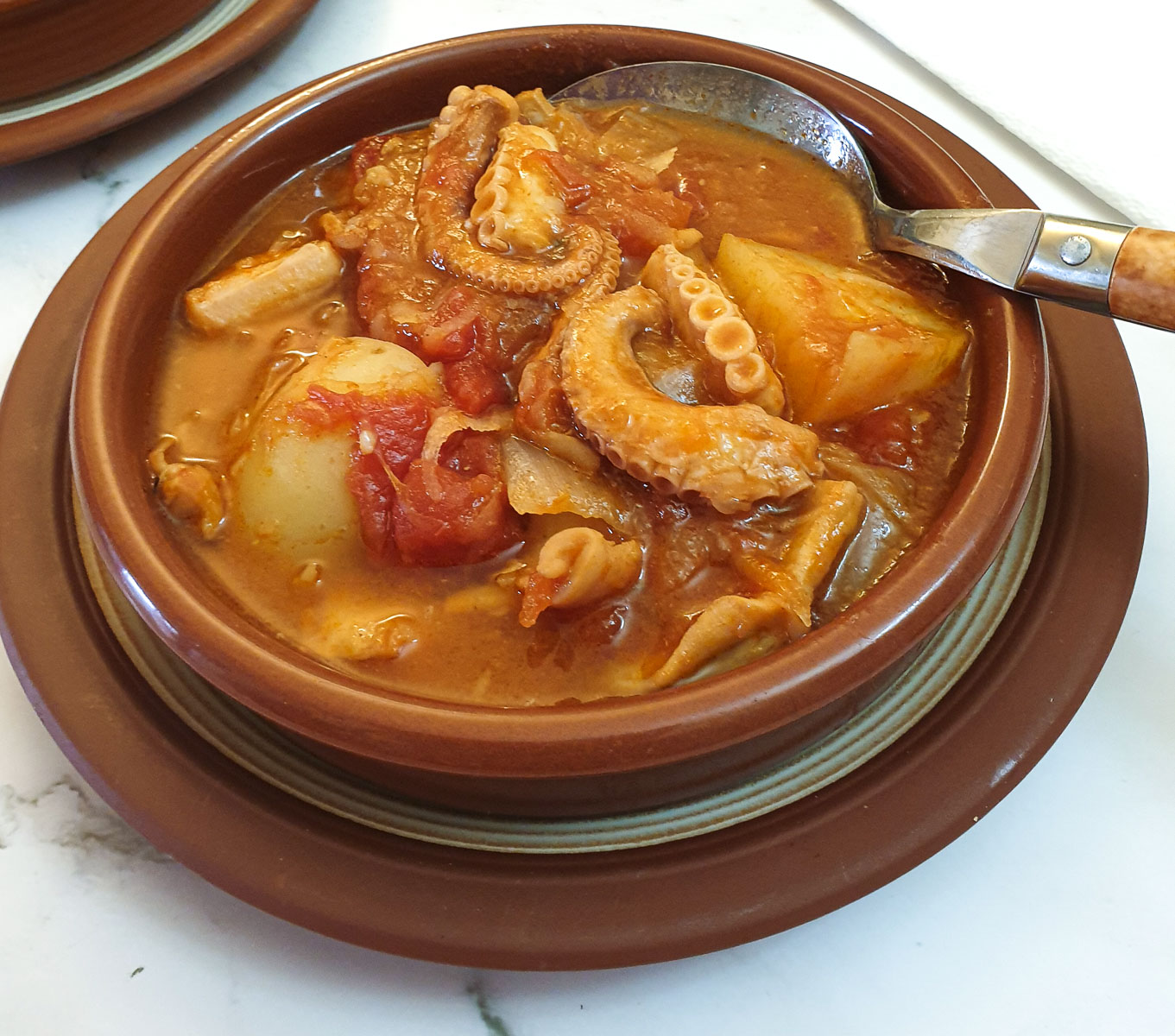
How to serve octopus stew
I like to serve this dish tapas-style, with lots of other dishes to accompany it. A tapas meal is a great way to get sociable with friends and family around the dinner table.
That said, this octopus stew would make a fantastic starter.
You could also turn it into a complete meal by adding extra vegetables to the pressure cooker when you add the potatoes. I think sliced red peppers would go well, as would a cup of shredded cabbage. The only other accompaniments you would need would be the crusty bread and a fresh green salad
More tapas recipes
If you are looking for other tapas recipes to make with the octopus stew, here are some you might like to try:
- Spanish croquettes with chorizo chicken
- Easy Spanish tortilla with new potatoes
- Blistered padron peppers
- And you can find another 50 tapas recipes on the BBC Good Food website.
Can I freeze octopus stew?
You can freeze any cooled leftover octopus stew in a suitable container for up to 2 months.
Defrost it in the refrigerator, then transfer it to a saucepan and reheat on the stove until piping hot. Serve immediately and do not refreeze.
Save for later
If you would like to try this octopus stew yourself, why not pin the recipe to one of your Pinterest boards so you can find it easily? Just click on the image below.
Alternatively, you can save the recipe by clicking on the floating heart icon on the right-hand side of the screen.
Related recipes
If this isn't quite what you are looking for, why not try some of my other fish and seafood recipes:
📋The recipe
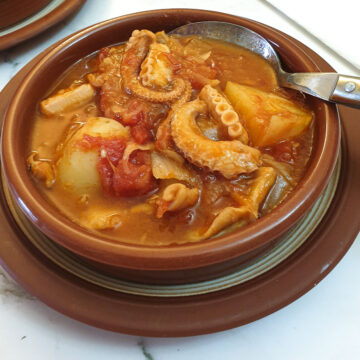
Octopus stew - Spanish style
(Click the stars to rate this recipe)
Ingredients
- 1 pound / 450 grams prepared fresh octopus
- 1 large onion Coarsely chopped and separated into petals
- 1 pound / 450 grams potatoes
- 14 ounce / 400 grams canned tomatoes
- 4 cloves garlic finely minced
- 1½ teaspoons paprika
- ½ cup / 120 ml white wine
- 1 vegetable stock cube dissolved in 1 cup boiling water
- 2 tablespoons olive oil
- ½ teaspoon salt optional
- 1 teaspoon sugar optional
Instructions
Preparation
- Lay the octopus out on a chopping board and cut off the tentacles.Then cut through the membrane between the top part of the tentacles to separate them.If the octopus is quite large you can cut these in half otherwise leave them whole.1 pound / 450 grams prepared fresh octopus
- Cut the body into rings approximately one-inch wide. Once again if the octopus is quite large you can cut the rings into two halves, otherwise leave them as rings.
- Cut the onion into largish pieces and separate the petals. Peel and mince the garlic.4 cloves garlic, 1 large onion
Stew
- Use the saute or browning function on your pressure cooker to soften the onions and garlic in 2 tablespoons of olive oil. Stir frequently so the onions don't burn. They should just turn translucent.2 tablespoons olive oil
- Add the stock, white wine, tomatoes, paprika, salt, sugar, and the octopus pieces.Set the pressure cooker to the 'Stew' function and then cook for 15 minutes.Allow the pressure to release.1½ teaspoons paprika, ½ cup / 120 ml white wine, 1 vegetable stock cube, ½ teaspoon salt, 1 teaspoon sugar, 14 ounce / 400 grams canned tomatoes
- Peel the potatoes and cut them into chunks. Keep one medium potato aside.Grate the medium potato on the largest holes of a box grater (approximately half a cup of grated potato).Add the grated potato to the octopus along with the remaining potatoes.Select the 'Stew' function and cook for a further 5 minutes.1 pound / 450 grams potatoes
- Release the pressure and check the consistency of the sauce.If the sauce seems too thin, set the pressure cooker to the saute or browning function and leave it to simmer for a few minutes (without the lid) to allow some of the liquid to evaporate.This sauce is not meant to be too thick, it should be runny enough to soak into the crusty bread.
- Serve with slices of crusty bread as part of a tapas meal.
Notes
- Brown the onions lightly in olive oil in a large saucepan.
- Add the rest of the ingredients (except the potatoes).
- Cover the saucepan with a lid and simmer for 60 minutes until the calamari is fork-tender.
- Add the grated potato and the chopped potatoes and cook for another 15 to 20 minutes until the potatoes are cooked and the gravy has thickened.
- Leave the lid off the pan for the last 5 minutes to allow some of the liquid to evaporate if the sauce seems too thin.
- Check the level of the liquid occasionally and add extra stock if necessary.
- Brown the onions lightly in olive oil in a frying pan on the stove.
- Transfer the onions to an oven-proof casserole dish, and add the remaining ingredients (except the potatoes).
- Cover with a lid and bake in a preheated oven (200C / 400F) for 90 minutes.
- Remove from the oven and add the grated potatoes and the chopped potatoes.
- Return the dish to the oven and cook for another 40 minutes until the potatoes are done.
- Remove the lid for the last 10 minutes if the sauce seems too thin.
- Check the level of the liquid occasionally and add extra stock if it seems to be drying out.
Nutrition
I am not a nutritionist. The nutrition information has been calculated using an on-line calculator, and is intended for information and guidance purposes only. If the nutrition information is important to you, you should consider calculating it yourself, using your preferred tool.





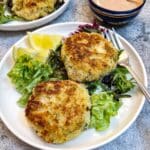








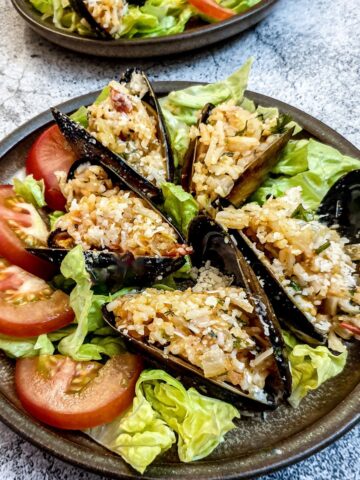
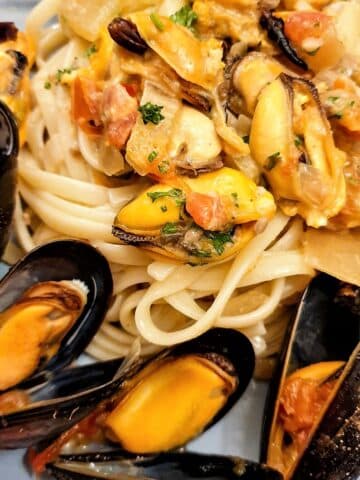
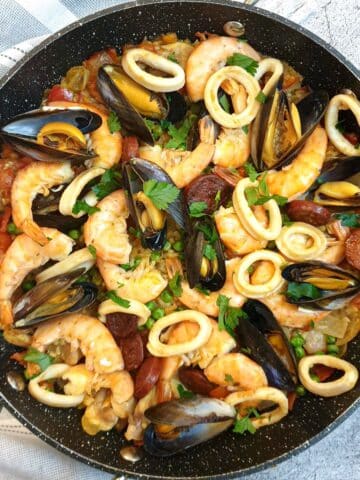
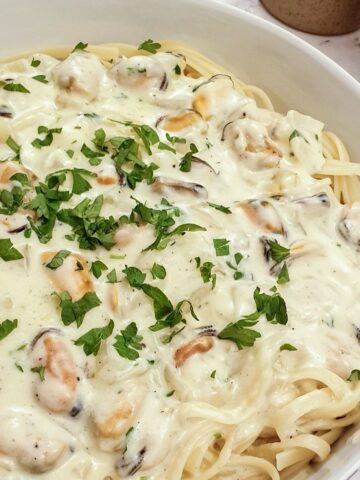

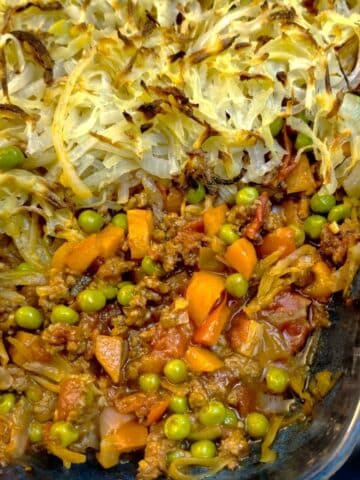
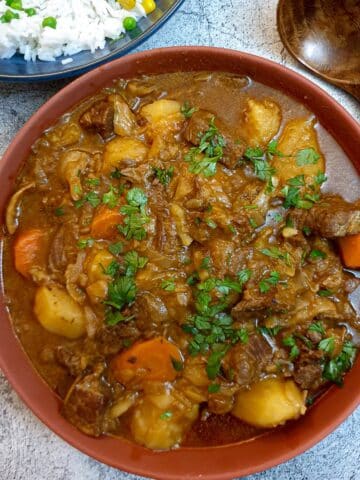

Did you make this recipe? Let me know!